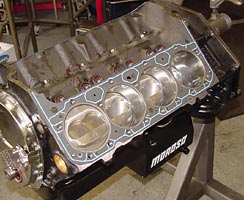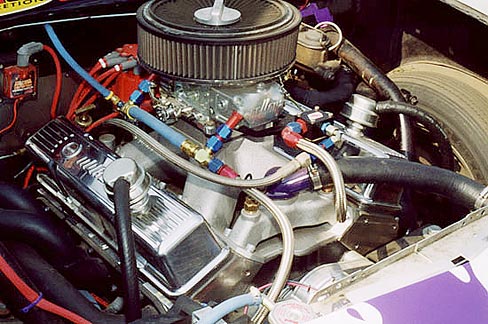
Now remember one important thing about this
combination: the pistons had small domes and
the cam just over a half-inch of lift. If you
have a lot of compression with a big dome on
the piston and a .650 lift cam you will have
to do all of the degreeing and checking we didn't
have to. Ditto for installing the lifters, push
rods and rocker arms. I just lubed everything
up well and installed them. If you've got high-dollar
solid lifter stuff there will be a lot more
work. Since putting the engine into the Vega
and racing it, Jok told me he basically hasn't
touched anything in the engine -- although he
did say that he felt so guilty that he actually
took the valve covers off once and ran the valves
just to make himself feel better.
We had the engine almost completely assembled
when we discovered that we had few extra Allen
head screw-in plugs left over. I had forgotten
to install the two threaded plugs that go behind
the timing chain assembly so I had to take that
stuff back off and screw those plugs in. We
also had a little brain cramp and got the upper
and lower bearing halves confused and had to
re-do that job.
 I
figure things like that are just part of the
deal when you are doing it yourself (at least
when I'm doing it). It taught me to check everything
at least twice. After those two speed bumps
the rest of assembly process very smoothly...sort
of. We did have a problem with having enough
hardware and gaskets. I
figure things like that are just part of the
deal when you are doing it yourself (at least
when I'm doing it). It taught me to check everything
at least twice. After those two speed bumps
the rest of assembly process very smoothly...sort
of. We did have a problem with having enough
hardware and gaskets.
I had no idea that gaskets, especially those
Fel-Pro blue gaskets, were so expensive or that
manufacturers no longer include hardware with
their parts. If you are building an engine from
scratch you better set aside time and money
to buy all the nuts, studs bolts and fasteners
required. I had to make several runs during
the process to buy head bolts, head studs, bolts
to install the intake with, bolts for the pan
and headers, and an oil pump shaft.
Despite those minor glitches we had the motor
assembled and ready for Jok in just two days.
 Once
the engine was bolted into the Vega it performed
better than we had expected. Jok put a Barry
Grant alky carb that we had used on the Project
4-Link dragster onto the Dart intake, hooked
up the MSD ignition that came with the Vega
when we bought it, and went to the track. Early
testing saw the Vega run the quarter-mile consistently
in the high 10.50's at 125+ and the eighth-mile
in the 6.60/100+ range. Once
the engine was bolted into the Vega it performed
better than we had expected. Jok put a Barry
Grant alky carb that we had used on the Project
4-Link dragster onto the Dart intake, hooked
up the MSD ignition that came with the Vega
when we bought it, and went to the track. Early
testing saw the Vega run the quarter-mile consistently
in the high 10.50's at 125+ and the eighth-mile
in the 6.60/100+ range.
Jok thinks that with a small roller camshaft
from Isky in the motor the Vega would run 9.90's
easily. In the meantime the engine the way it
is with a hydraulic cam that limits the engine
to 7500 rpm will probably last for a very long
time before it needs any maintenance.
Jok and I had budgeted about $13,000 to build
the Back to Basics Vega project and that included
the engine. As it turned out we probably got
close to that figure, but just barely. We have
about $4,500 worth of parts in the engine based
upon the retail prices and made an alky burning,
single four-barrel, 383-inch mouse motor that
has pushed our 3,000 lb Vega project car to
consistent 6.60/104 laps on the eighth and a
best of 10.59/125.60 in the quarter. According
to our charts the engine has to be making about
520 hp.
What I learned from this was that you can build
a "budget" engine using off-the-shelf
speed parts that will make plenty of power and
that you won't have to sell the kids into white
slavery to finance the project. The secret,
if there is one, is to trust what the manufacturers,
your local speed merchant, and machinist tell
you. Buy and install the parts they recommend
and stick to the basics.
| SOURCE
BOX |
Ohio
Crankshaft
5453 SR 49 Greenville, OH 45331
800-333-7113
www.ohiocrank.com
|
Isky
Racing Cams
16020 S. Broadway
Gardena, CA 90247-9990
213-770-0930
www.iskycams.com |
Dart
Machinery
353 Oliver Drive
Troy, MI 48084
248-362-1188
www.dartheads.com |
Moroso
Performance Products
80 Carter Dr
Guilford, CT 06437
203-458-0542
www.moroso.com |
Don
Kulash
Precision Engine Service
Glen Carbon IL
618-288-3779 |
Bill
Weckman
Weckman Racing Engines
Granite City, IL
618-876-1762 |

|